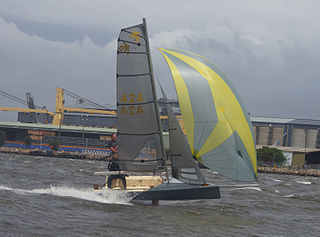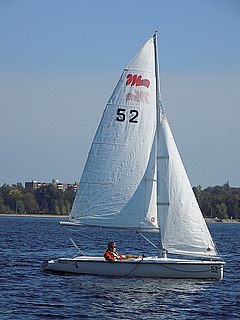
The Lightning is an American sailing dinghy that was designed by Olin Stephens of Sparkman & Stephens as a one-design racer and first built in 1938.

The Hobie Cat is a small sailing catamaran manufactured by the Hobie Cat Company. Hobie's line of products includes surfboards, sailboats, kayaks, stand-up paddle boards, and pedalboards, although the Hobie Cat Company is known worldwide for its catamarans. Hobie also designed a successful monohull, the Hobie 33.

The Laser Pico dinghy is a small sailboat designed by Jo Richards in the mid-1990s and used primarily for training and day sailing. It can be crewed by one or two children or an adult. Current models come equipped with both a mainsail and a jib, the jib however mainly functions as a training tool and provides little to no contribution to speed. The Pico functions mainly as a training boat for younger children because of its very durable nature and has little to no racing events dedicated to it.

The Jet 14 is an American sailing dinghy that was designed by Howard Siddons as a one-design racer and first built in 1952.

The 29er is a two-person high performance sailing skiff designed by Julian Bethwaite and first produced in 1998. Derived from the Olympic class 49er class, it is raced in the ISAF Youth Sailing World Championships. The 29er is able to reach high speeds fairly quickly by having a sleek and hydrodynamic hull and will often exceed the wind speed when planing both up and downwind.

The 3000 is a racing sailing dinghy crewed by two persons with a trapeze for the crew. Launched in 1996 as the Laser 3000, the 3000 was developed from the Laser 2, using the original Frank Bethwaite-designed planing hull combined with a new designed self-draining deck by Derek Clark. Clark also re-designed the rig, using spars and sails from premium proprietary sources and replacing the symmetric spinnaker of the Laser 2 by a larger asymmetric spinnaker (gennaker). The gennaker is chute-launched and retrieved using a single halyard line, and is set on a retractable bowsprit. Helm balance and handling were improved using a shorter-footed mainsail with two full-width battens giving a larger roach. A mast with conventional spreaders replaced the now-unusual diamond arrangement of the Laser 2.

The Banshee, sometimes called the Banshee 13, is an American sailing dinghy that was designed by Richard L. Reid as a one-design racer and first built in 1969.

MG14 is a two-person skiff with a high-performance development hull, single trapeze and asymmetrical spinnaker.

The Buzz is a sailing dinghy designed in 1994 by Ian Howlett and John Caig and manufactured by Reg White Limited of Brightlingsea as part of the "White Formula" range of boats originally marketed by Topper International Ltd but since 2013 by Vantage Sailing. The Buzz is a double handed racing boat, with a single trapeze for the crewman. The boat has a fully battened mainsail, furling jib and an asymmetrical spinnaker. There have been around 500 boats built. The Buzz is designed to be an easy to sail boat, but it can also be raced competitively.

The Topaz Vibe is a British sailing dinghy designed by Ian Howlett and Rob White. Built by Topper International, it was first introduced in 2006. There are two models, the Vibe and the Vibe X, with the latter carrying larger sails. The Vibe is a World Sailing Learn to Sail class.

The Martin 16 is a Canadian trailerable sailboat, that was designed by Don Martin of Vancouver, British Columbia, specifically as a boat for disabled sailors. It was first built in 1995.
The Freedom 25 is an American sailboat that was designed by Gary Hoyt as a single-handed racer-cruiser and first built in 1980.

The Hobie Wave is an American catamaran that was designed by Morrelli & Melvin and first built in 1994.
The Puffer is an American rowboat, motorboat and sailing dinghy that was designed by Fred Scott and first built in 1972.

The Hobie 14 is an American catamaran sailing dinghy that was designed by Hobie Alter and first built in 1967.
The Phantom 14, also called the Phantom 14', is an Italian catamaran sailing dinghy that was first built in 1995.
The Nacra 5.2 is an American catamaran sailing dinghy that was designed by Tom Roland as a one-design racer and first built in 1975. Other that the small production run Nacra 36, the Nacra 5.2 was the first Nacra brand boat and established its reputation.
The Skipjack 15 is an American sailing dinghy that was designed by Harry R. Sindle and Carter Pyle and first built in 1965.
The Prindle 18 is an American catamaran sailing dinghy that was designed by Geoffrey Prindle as a racer and first built in 1977.
The Transit 380, styled as the Transit_380 or T_380, is an American sailing dinghy that was designed by Jim Taylor for youth sail training and first built in 2005. The boat was intended to act as a "transition" boat between the Optimist dinghy and more high performance boats. The designation indicates the length overall in centimeters.














